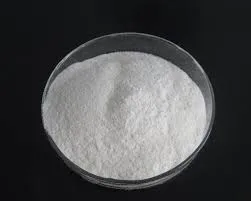
Nov . 22, 2024 10:16 Back to list
hpmc for wall putty
HPMC for Wall Putty Enhancing Performance and Quality
Hydroxypropyl Methylcellulose (HPMC) is a widely utilized cellulose ether in the construction industry, particularly noted for its effective application in wall putty formulations. The increasing demand for high-quality wall finishes and the rising construction activity worldwide have spurred interest in the use of HPMC as a key ingredient in wall putty. This article delves into the significance of HPMC in wall putty, discussing its properties, benefits, and applications.
Understanding HPMC
HPMC is a water-soluble polymer derived from natural cellulose. Its unique structural properties allow it to function effectively as a thickener, binder, and stabilizer in various construction materials. Classified as a non-ionic cellulose ether, HPMC is characterized by its ability to hold water, impart viscosity, and enhance workability without significantly altering the material's other properties.
Role of HPMC in Wall Putty
Wall putty is a white, powdery substance used to create a smooth surface on interior and exterior walls before painting. The incorporation of HPMC into wall putty formulations significantly improves its performance. Here are some key roles HPMC plays in wall putty
1. Improved Workability HPMC enhances the workability of wall putty, making it easier to apply and spread. This characteristic is particularly important for workers, as it allows for a smoother application, reduces the risk of surface imperfections, and ensures a uniform finish.
2. Water Retention One of the standout features of HPMC is its exceptional water-retention capability. This property is crucial in wall putty, as it prevents premature drying of the mixture during application. Sufficient water retention ensures optimal curing, which ultimately leads to stronger adhesion and a more durable finish.
3. Adhesion Properties HPMC contributes to the adhesive properties of wall putty, ensuring that the material bonds well to various substrates. Strong adhesion is vital for preventing flaking or peeling over time, particularly in environments with fluctuations in temperature and humidity.
hpmc for wall putty

4. Thixotropic Behavior HPMC exhibits thixotropic properties, meaning it can change viscosity under stress. This quality allows wall putty to remain thick during application, preventing sagging, while becoming more fluid when agitated. This dual nature improves application ease and enhances the overall quality of the plastering work.
5. Compatibility with Other Additives HPMC is chemically compatible with various other additives commonly used in wall putty formulations, such as pigments, binders, and other cellulose ethers. This versatility allows manufacturers to customize their wall putty products to meet specific performance requirements.
Benefits of HPMC-Based Wall Putty
The integration of HPMC into wall putty formulations provides numerous benefits that contribute to enhanced performance, longevity, and aesthetic appeal. Some of these advantages include
- Sustainability HPMC is derived from renewable resources, making it a more environmentally friendly option compared to synthetic alternatives. This aspect appeals to eco-conscious consumers and aligns with the increasing push for sustainable building practices.
- Cost-Effectiveness Though the initial cost of HPMC may be higher than that of traditional additives, the benefits it provides in terms of workability, adhesion, and durability can lead to cost savings in the long run. Reduced labor time and fewer application layers result in overall project efficiency.
- Aesthetic Quality The smooth finish facilitated by HPMC-enriched wall putty enhances the aesthetic quality of interior and exterior walls. A flawless surface is essential for a professional appearance, and wall putty plays a critical role in achieving this.
Conclusion
The use of Hydroxypropyl Methylcellulose in wall putty formulations represents a significant advancement in construction material technology. Its attributes of improved workability, water retention, adhesion, and thixotropic behavior contribute to enhanced performance and sustainability. As the demand for high-quality finishes continues to rise, the role of HPMC in wall putty is sure to become even more prominent, driving innovations that will shape the future of the construction industry. This powerful additive not only supports the creation of aesthetically pleasing surfaces but also promotes longer-lasting and more reliable construction practices.
-
Versatile Hpmc Uses in Different Industries
NewsJun.19,2025
-
Redispersible Powder's Role in Enhancing Durability of Construction Products
NewsJun.19,2025
-
Hydroxyethyl Cellulose Applications Driving Green Industrial Processes
NewsJun.19,2025
-
Exploring Different Redispersible Polymer Powder
NewsJun.19,2025
-
Choosing the Right Mortar Bonding Agent
NewsJun.19,2025
-
Applications and Significance of China Hpmc in Modern Industries
NewsJun.19,2025







